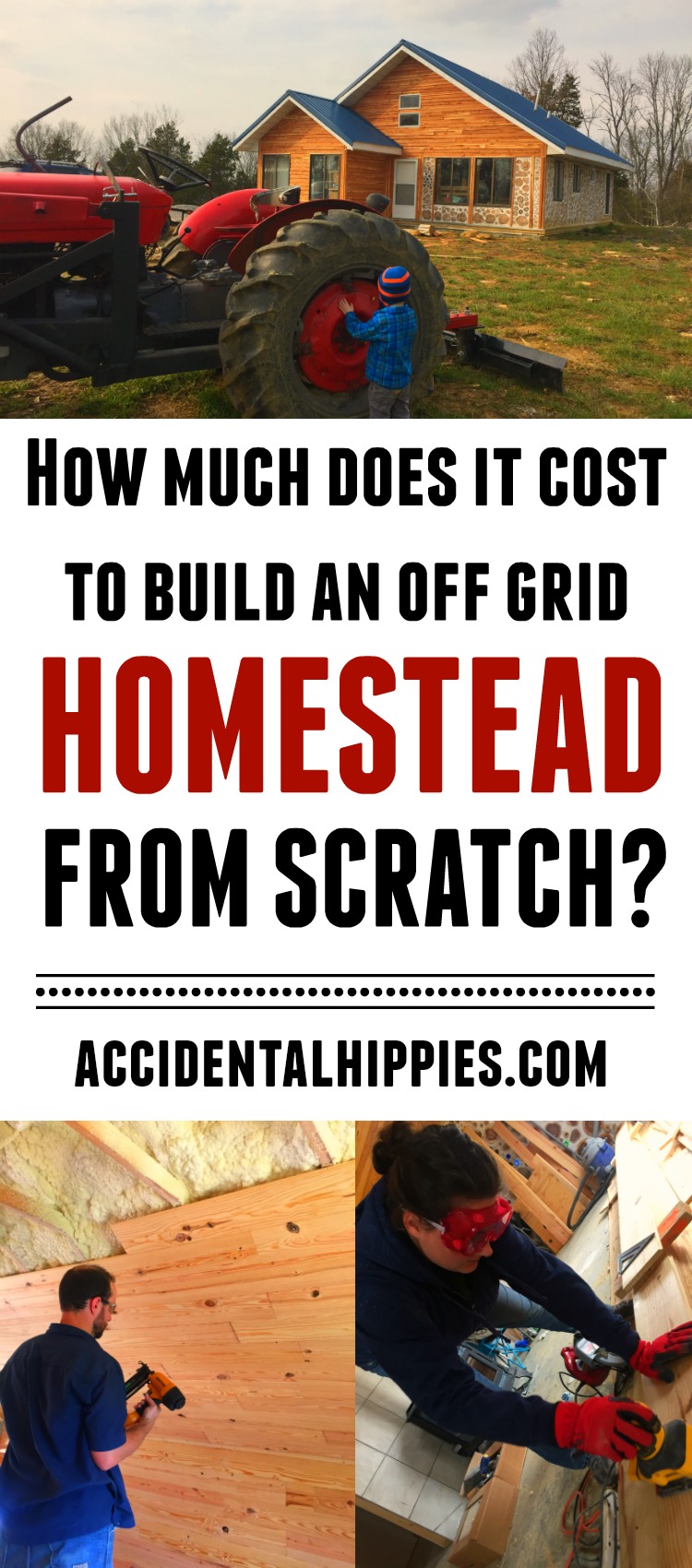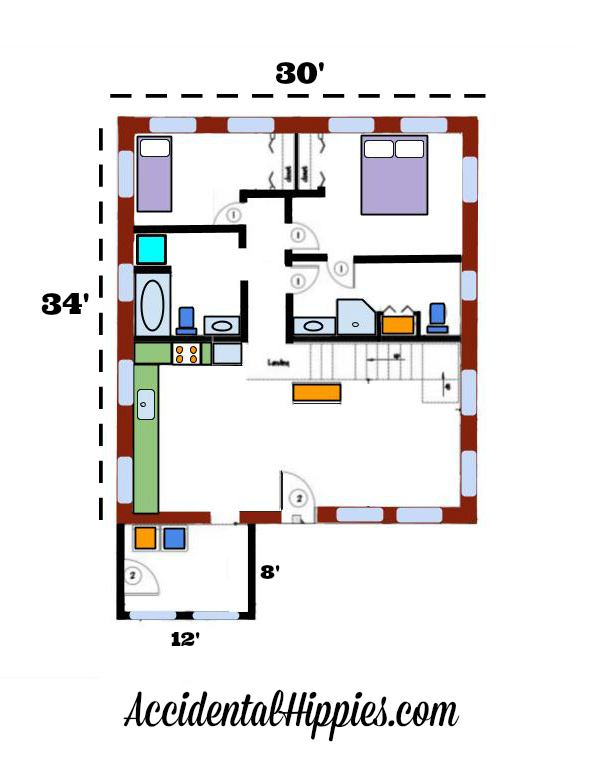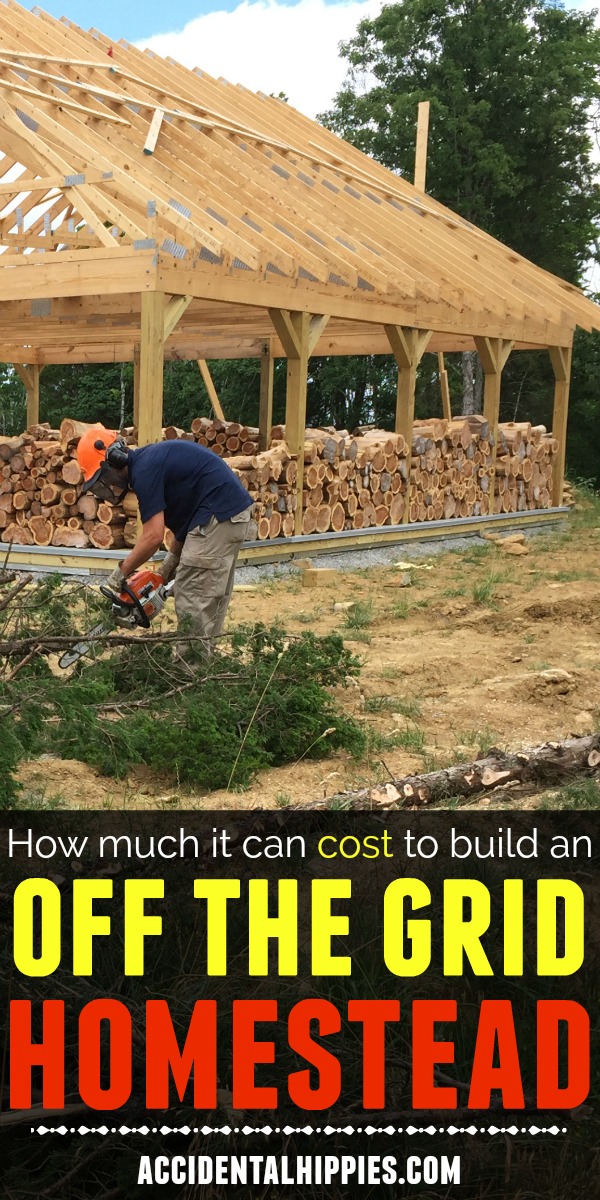Disclosure: I sometimes earn products or commissions from affiliate links or partnerships on my blog. I only recommend products and services I trust to serve you. Learn more.
Lots of people dream of building a homestead from scratch, but worry about the cost to do so. Is it expensive? How can you reduce your cost? We’ll explore the cost to build a homestead from scratch, including our experience building a cordwood house on raw land.
If you’re like a lot of people, you might be dreaming of the opportunity to buy some land and build yourself a homestead. You fantasize about your home layout, the gardens you might have, and peaceful country living. But you hesitate do it it. Why?
You worry about the cost of building.
We get a lot of questions about how much it costs to build a home from scratch. While the answer to this question can vary wildly based on your personal choices, building your own homestead doesn’t have to break the bank.
To help you out, we’ll show you how we built our home and tell you exactly how much it cost to build it.
How Much Does It Cost To Build a Homestead From Scratch?
The answer to this question varies a lot depending on many different factors. What the cost ends up being for YOU may depend on:
- Geographic location
- Cost of land in your area
- Amount, type, and zoning of acreage
- Size of house
- Building method and materials
- Permitting fees
- Choice of home systems for power, water, and waste water
- Home design choices
- Building and hiring choices made throughout the build
Managing some of these factors differently would have saved us THOUSANDS of dollars. If you want to avoid shelling out some serious dollars read more here.
About Our Homestead Build
To give you a better idea of how much it costs to build from scratch, here are some details on our property and building project. Use this information to give context when you find out the total cost.
About the Land:
- 16.4 acres of raw land, partially wooded, hilly with a flat building site at the top
- Located in KY, not too far from major towns/shopping/infrastructure (so not the cheapest part of the state but not the most expensive either)
- Half mile long driveway with an easement (which likely lowered the cost potential of the land)
About the House:
- Cordwood construction
- 3 bedrooms (two on the first floor, one more in the loft)
- 2 full bathrooms
- Completely solar powered
- Cistern with rainwater catchment from the roof
- Septic tank and field for waste water
- 30’x34′ footprint with a loft (room-in-attic trusses)
- 1140 square feet of living space
What was the process, start to finish, to build on raw land?
Planning:
The planning phase took roughly 1-2 years. We began looking for land in the spring of 2014, sold our old home in February 2015, and purchased our 16 acres of raw land in March 2015.
It took until April 2016 to actually break ground on our foundation, so it was basically one year from the purchase of land to groundbreaking. In that time we prepped trees for our cordwood masonry, planned our home’s layout, took care of all the permitting, and lined up contractors to do our excavation/septic and foundation.
Related: 8 things to prep before you build your home
Building:
It took us from April 2016 to roughly December 2016 to go from a foundation to a fully closed in home. After that we completed exterior trim and all of the interior work.
We completed the vast majority of jobs by HAND. Also, we hired out select items when it was either safer or sometimes cheaper to do so.
We finished our home enough to receive a final occupancy permit in December 2017 and moved in just a few days before Christmas. There is still a LOT of trim work to do, but we’re taking a little time off to rest before we dive into all that.
You can view a complete listing of building update posts here. If you are seriously considering building a cordwood home you should read through our update posts to see exactly what building your own home entails.
Cost to Build
Here’s where things get tricky in most articles out there telling you how to build a home for some ridiculously low price.
Can you build a home for $5000? Absolutely! I’ve seen articles about building homes for $20,000 and $40,000, which is what got us interested in the first place. Those numbers seem realistic and attainable, and they certainly can be! I’m pretty confident you can build for even less than we did.
BUT…
A lot of articles are simply listing the cost of building materials. They don’t necessarily include the cost of any applicable permits (if any), site prep, utilities or off-grid systems, labor (if hiring any contractors), etc. So when you see those articles, take them with a grain of salt. The price is meant to draw you in.
So what DID it cost us anyway?
We kept track of everything in a spreadsheet and scanned in all receipts. Below you’ll see our overall costs followed by a breakdown of costs by category.
Total Cost of Materials/Labor/Tool Rental: $80,204.98
Material Cost of the House: $67,076.37
Labor: $11,868.00
Permit: $736.20
Rental: $524.41
——————-
Miscellaneous: $8,352.55 (includes our tractor, shed, tools, and related items without which our home build wouldn’t have been possible)
So while the house itself cost us $67,655.36 in materials, EVERYTHING from permits to labor, materials to tools and rental cost us…
$88,557.53
Add in the cost of the land itself and the total cost is $148,557.53
Cost of Individual Components
I’m hoping to break this down in greater detail once I finish combing through the spreadsheet, but I at least wanted to address some of the big ticket items so you have an idea of where this cost is coming from.
Radiant Heat System: $7,500
Off Grid Solar Power System: $10,000
Soapstone Wood Stove: $5,000
Spray Foam Insulation: $6,000
Metal Roof: $6,000
Trusses: $4,000
Tongue and Groove Pine: $6,000
Excavation, Site Prep, and Septic: $10,000
Cistern and Rainwater System: $2,200
Foundation: $13,000
More coming as I complete the list…
Did we complete it debt free?
This was something we really wanted to be able to do. Aside from our land loan, we wanted to be able to complete the house without borrowing money.
We got about $55,000 into the build when we realized a few things.
First, that we wouldn’t have the cash on hand to be able to do all of the big systems we needed to in the time they needed to be done. For example, we needed to finish the septic and cistern installations while the ground was still in good condition or else wait another full year to do it.
Second, that for our son’s sake I needed to leave my job to be home with him. Maintaining our busy working schedules on top of building a home was taking its toll on his behavior and health. Unfortunately, we were living on MY income and using my husband’s to pay cash for the build as we went.
So we determined that taking a small construction completion loan was ultimately the best choice for our family.
Fortunately, things have a way of working out.
Not only was my husband presented with a raise some months later, but THIS BLOG has become an actual revenue stream for us that has just about replaced my old income. In a weird way, we’re back to where we started.
We had no idea when we made those decisions how it would all turn out, but we are grateful and humbled by the divine providence that lead us here.
I’ll be diving into all of this in more detail in subsequent posts. It’s something I haven’t really addressed directly because I know a lot of people were really hoping along with us to be mortgage free.
HOWEVER, I also know that there are so many different money situations out there.
I don’t want anyone to feel like they can’t build their own homestead or feel like they have to be a slave to some idealized notion of freedom and self-sufficiency.
To do so ignores reality.
I want to help you on your path to self-sufficiency and for you to know that there is more than one way to get there.
How can we help you dive into your own building project? Let us know! Leave a comment below, shoot me an email, or join the discussion over on our Facebook page. We’d love to have you there!
If you’re serious about building your own home, grab our free quick-start guide for owner-builders to help you get started:
In the meantime, we’ve got a load of great financial information for the aspiring owner builder here:
Natural Building and The Code: A Quick-Start Guide for Owner Builders
Financing Your Homestead (even if you’re flat broke)
6 Financial Tips for Buying Land for Your Homestead
Buying Land: 5 Things To Do Before You Purchase
10 Ways to Save THOUSANDS of Dollars on Your Home Build
6 Reasons You’ll Blow Your Construction Budget (and how to avoid it)
9 Ways to Get Building Materials Cheap or Free
7 More Great Ways to Score Inexpensive Building Supplies
Check out our homestead progress reports and find out more about our cordwood homestead project here. You should also join us on Facebook, Twitter, and Instagram. I’m always pinning lots of great ideas on Pinterest too! Thanks for reading!





Wonderful, a realistic view on building and all the “side” projects needed for a homestead.
Thanks! 🙂
way too expensive, i built a better cheaper home for $75k aus .
There’s a huge range of price points and everyone’s build will be a bit different. Prices and material options will also vary widely based on your geographical location, and better is purely a matter of perspective. This is only to give people an idea of what is possible and what might be realistic. Good for you building your home for $75k aus. That looks like about $56,382.00 US right now, which was our original goal. Didn’t pan out that way for us, but I’m glad it worked out for you.
Hello,
I am embarking on a similar journey in Central New York and am wondering if you needed an architectural stamp to get your permit. If so, what resources did you use for the floor plan documents/was it custom?
Thank you,
Emma
We almost needed one. We had to make some modifications to our foundation in order to meet our code for pole frames as residential structures in order to get around the need for a stamp. Our building plans were drawn up by cordwood draftsman Rob Pichelman, who did the plans for Richard Flatau’s home, among others. You can get more info here: http://cordwoodconstruction.org/img/Cordwood_House_Plans_by_Draftsman_Rob_PIchelman.pdf
Awesome! Thank you so much!
Another question that might not have such a straightforward answer…
As I am stockpiling wood, how much wood should I be preparing if I plan to have a similar footprint to your own. I’m thinking a 30′ x 40′ structure without a loft space and 16″ walls. I’ve found wildly varying quantities, and just want to be sure I’m in the ballpark as I am collecting logs.
Thank you,
Emma
Short answer: much more than we cut! We ran out and had to get some white pine posts to cut to 16″ lengths at the last minute. We did not store our wood to try in the typical face cord dimensions so I honestly don’t know how many face cords we used. BUT there is a formula I learned from Rob Roy that you can use to figure it out.
You’ll be dealing with face cords, which are 4 long by 8 feet high and match the thickness of your walls. Find the square footage of the WALLS you’ll be building and divide by 32. So for example if you have a 30×40′ structure with 8 foot tall cordwood walls that is roughly 1,120 square feet of walls in total. Divide this by 32 and you get roughly 35 face cords of wood. Take 80% of this figure to account for doors and windows and you get 28 face cords. That should get you enough to account for any pieces you have to throw out.
In the process of that, don’t forget to save pieces of ALL sizes and shapes as long as they are in good condition and don’t have rotten parts. You’ll need little logs to fill in some parts where large ones just don’t work. You’ll also likely need some short pieces that are maybe 6-8 inches deep if you’re building around your posts on the inside of the walls like we did. You can’t actually see any of our posts from the inside of the house. If you use a double post system or have posts that are already 16″ thick then this isn’t an issue, but it is worth noting for those who choose to build with single posts like we did.
Hello, I’m interested in your rainwater and cistern system. Do you use that for all your household and living needs? Is it then filtered before use and if so how? No well? How much are you storing?
No problem! The quick answers are: yes, yes with a single stage particulate filter, no well, 2400 gallons. The detailed answers are in this post:
Curious, how is it possible that you do off grid solar system for $10,000? Batteries for off grid/back up alone is $4,800
You know, I’d have to go dig out the invoice from our solar orders to list it all out. That being said, costs vary widely depending on the specs you want. Our battery bank is 4 of these, and we had similar or slightly less cost in that with our wholesale bundle: https://www.batterywholesale.com/products/universal-ub8d-agm-12v-250ah-sealed-agm-battery?variant=8085547941941&utm_campaign=gs-2019-01-24&utm_source=google&utm_medium=smart_campaign&gclid=CjwKCAjw7MzkBRAGEiwAkOXexJkSDZqH_cBuLxxBLJiPsBd-4QrvXShAJrgP3UAeO1EpAHj5XfO9dhoCADEQAvD_BwE
Thank you for such an informative website!
Have you detailed the expenses yet?
I’m wondering how much, and what specifically, you subbed out? We’re trying to figure additional costs for hiring labor to help build, and the cost for plumbing and electrical contractors. Also, we’re older and with zero building experience so we’d likely need a skilled carpenter to oversee everything. How much do you think it would add to the cost for adding skilled labor such as this?
Thanks again!
I had a huge comment replying to this and WordPress just ate it! So I’ll try again.
Short story is no, I haven’t detailed all the little expenses the way I thought I would. The spreadsheet is super hairy to look at and not quite as helpful to folks as I had anticipated. There’s a lot of “Box of nails – DATE – $6.47” and “Bagged Lime – DATE – $145.37” that won’t self-sort in the list, so I just haven’t devoted the time to rip it apart when I’ve been able to create more helpful things. Suffice to say a lot of homebuilding costs are eaten up with weird trips to the hardware store.
We subbed out the site grading/septic, spray foam insulation, seamless gutter fabrication/install, wood stove install, and the roof. Our deciding factor was always that if someone else could do it faster, cheaper, and better than us then we would hire it out. Generally those were things that were up high, specialized, and/or involved heavy machinery.
If you have zero experience, it’s possible to hire a general contractor and then DIY certain jobs yourself to save money. My parents did this when they built the house I grew up in. My uncle was an experienced GC who oversaw the construction, and my parents helped with things like staining/installing trim and painting walls. Look for your risk tolerance and decide what is worth it to you or not. If my husband had not been so knowledgable of building code and adept at different construction skills, I probably would have gone that route myself. However, with him acting as the foreman I could put my construction skills to work and we saved money overall. A good chunk of the cordwood and tongue-and-groove was just me working solo.
As for cost of labor, the general figure for hiring a GC is that 20% of your home’s cost is their fee. However, when you dig through the subcontractors who come in to do jobs like insulation or plumbing, their cost is really 20-50% of the price you pay them. It’s a bit like taking your car to the mechanic, in a sense. So yes, you can save a TON of money as owner-builders if you’re ONLY paying for materials, but if you have zero experience then that likely isn’t the most reasonable route to go. Fortunately, it doesn’t have to be and either/or thing. You can hire it all out, hire none of it out, or hire out some things. Look at your skills, your time, your willingness to take risks or not, and your budget and sort of go from there.
Hope that helps!